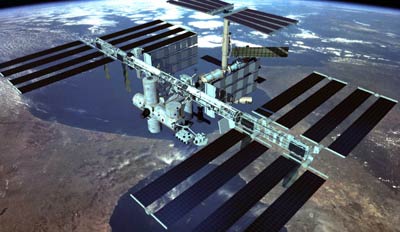NASA and ESA: a parting of ways?by Taylor Dinerman
|
| ESA is evolving into a unique organization whose main ambitions involve France’s long-standing desire to make “Europe” into a new superpower, rather than the more prosaic goals of other Europeans. |
NASA is emphasizing the completion of the final shuttle flights and the design and development of the Crew Launch Vehicle and the Crew Exploration Vehicle. It is following the Bush Administration’s vision as reaffirmed by the US Congress in last December’s NASA authorization bill. In Washington, 2005 will be remembered as the first year since the era of Apollo that both the executive and legislative branches came to a firm agreement on the future goals for America’s human spaceflight program. NASA administrator Mike Griffin’s main task will be to sustain and broaden this consensus. Getting back to the Moon and staying there is going to be at least a twenty-year-long effort, and doing so will require both political will and budgetary discipline.
ESA, with its much smaller budget, still wants to do a little of everything. It wants to support Europe’s launcher and satellite industries. It also wants to support robotic exploration and its aforementioned quasi-military role. It will also continue its partnership with the US, Russia, and Japan on the International Space Station. Jean-Jacques Dordain, ESA’s Director General, announced that, sometime this year, they will be shipping the Columbus laboratory module from Germany to Cape Canaveral, to be delivered to the ISS on a future shuttle mission. He said, “We can permit ourselves to be confident that Columbus will be launched and utilized.”
According to ESA, they are now on track to launch the Jules Verne Automated Transfer Vehicle (ATV) to the ISS sometime in 2007. For both the Europeans and for the space station, this will be a major step forward. The ATV will be one of the major resupply systems needed to keep the station operational after 2010, when the shuttle is retired. Russia’s Progress capsules have done excellent work since the Columbia disaster, but it is now showing its limits. If the larger ATV is a success, it will be an important factor in any decision to increase the ISS crew size.
Dordain also announced that ESA will begin talks with the Americans on their participation in NASA’s lunar exploration program. This will be tricky since Griffin has made it clear that all the elements in the so-called “critical path” will be American. In this he really had no choice. There is little appetite for international cooperation on Capitol Hill. The foreign policy arguments that the Clinton Administration used to promote the ISS in 1993 and 1994 no longer apply. America is planning to go back to the Moon. If it succeeds it will be an American triumph; if it fails, it will be an American failure.
There is room for cooperation in the various scientific aspects of the program. Data will be shared and there will be lots of room for European instruments to fly on US space probes (and vice versa) and even for European astronauts to travel to the Moon on American CEVs. However, the US government has made it plain: the command and control of this effort is going to remain in Washington.
Philosophically, this is not going down well in Europe. Their belief in multilateralism for its own sake, and their distaste for the Bush Administration, to say nothing of generic anti-Americanism, puts limits on their willingness to be “loyal followers” in any blatantly American-led program.
| There is room for cooperation in the various scientific aspects of the program. However, the US government has made it plain: the command and control of this effort is going to remain in Washington. |
Last September, writing in the left wing Paris newspaper Liberation, Sylvestre Huet wrote: “To go back to the Moon to build a scientific base, to prepare for a Mars mission that will help to discover the origins of the solar system and its relations or not with life on Earth… This looks like an open, peaceful program of scientific cooperation, with no one showing any will to dominate it and one that needs a regular source of financing. Bush or any his successors who want to imitate Kennedy and his show of force will not carry out such a program. The European Union could do so if it wanted to, with a rational and progressive program, structured around scientific objectives, and one day, under the flag of the UN.”
This is as good a representation as any of what the Europeans want to see happen. It is not what the US wants or is ready to pay for. This fundamental political incompatibility will continue to haunt any effort to restore close cooperation between the US and the European space programs.
